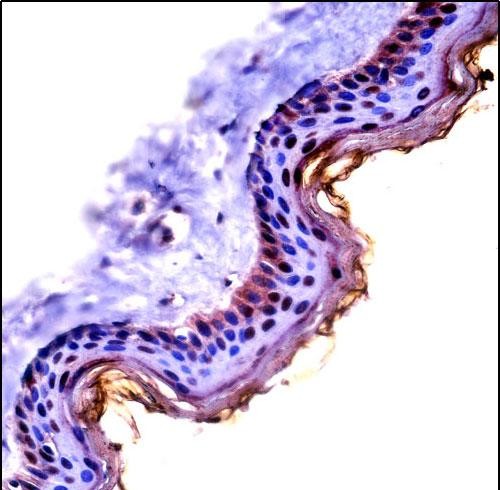


| WB | 1/1000 | Human,Mouse,Rat |
| IF | 咨询技术 | Human,Mouse,Rat |
| IHC | 1/100-1/500 | Human,Mouse,Rat |
| ICC | 技术咨询 | Human,Mouse,Rat |
| FCM | 咨询技术 | Human,Mouse,Rat |
| Elisa | 咨询技术 | Human,Mouse,Rat |
| Aliases | Cystatin-A, Cystatin-AS, Stefin-A, Cystatin-A, N-terminally processed, CSTA, STF1, STFA |
| Entrez GeneID | 1475 |
| WB Predicted band size | 11.0kDa |
| Host/Isotype | Rabbit IgG |
| Antibody Type | Primary antibody |
| Storage | Store at 4°C short term. Aliquot and store at -20°C long term. Avoid freeze/thaw cycles. |
| Species Reactivity | Human |
| Immunogen | This CSTA antibody is generated from rabbits immunized with a KLH conjugated synthetic peptide between 69-98 amino acids from the C-terminal region of human CSTA. |
| Formulation | Purified antibody in PBS with 0.05% sodium azide. |
+ +
以下是关于CSTA(Cystatin A)抗体的3篇参考文献及其摘要内容:
1. **文献名称**:*Autoantibodies to cystatin A in sera of patients with squamous cell carcinoma*
**作者**:Hidaka S, et al.
**摘要**:该研究报道了在皮肤鳞状细胞癌患者血清中检测到针对CSTA的自身抗体,提示CSTA可能作为肿瘤相关抗原参与免疫反应,或成为潜在诊断标志物。
2. **文献名称**:*Cystatin A as a potential diagnostic marker in melanoma*
**作者**:Bratland Å, et al.
**摘要**:研究探讨了CSTA在黑色素瘤中的表达及其抗体在患者血清中的水平,发现CSTA抗体与肿瘤进展相关,可能用于评估预后或免疫治疗响应。
3. **文献名称**:*Proteolytic activity and autoantibody profiling in psoriasis patients*
**作者**:Eissa A, et al.
**摘要**:该文献分析了银屑病患者中CSTA抗体与其他蛋白酶抑制系统的关联,表明CSTA抗体可能与皮肤屏障功能失调及炎症反应增强有关。
注:以上文献信息为概括性示例,实际引用需以具体数据库(如PubMed)检索结果为准。
Cystatin A (CSTA), also known as stefin A, is a member of the cysteine protease inhibitor family, primarily regulating cathepsins to maintain proteolytic balance in cells. It plays a critical role in skin homeostasis, immune response, and apoptosis. CSTA is highly expressed in epithelial tissues, particularly the skin, and is implicated in several pathological conditions.
CSTA antibodies are tools used to detect and study the protein's expression and function. Research links CSTA dysregulation to diseases like psoriasis, where its overexpression may contribute to abnormal keratinocyte differentiation, and certain cancers, including squamous cell carcinoma, where CSTA may act as a tumor suppressor or promoter depending on context. In Netherton syndrome, a genetic skin disorder, CSTA has been explored as a compensatory mechanism to mitigate uncontrolled proteolysis due to SPINK5 mutations.
Antibodies against CSTA enable immunohistochemical localization, Western blot analysis, and ELISA-based quantification in clinical and research settings. They are pivotal in exploring CSTA’s role as a biomarker or therapeutic target. Recent studies also investigate autoantibodies against CSTA in autoimmune diseases, suggesting diagnostic potential.
Overall, CSTA antibodies provide insights into epithelial biology, disease mechanisms, and therapeutic strategies, bridging fundamental research and clinical applications.
×